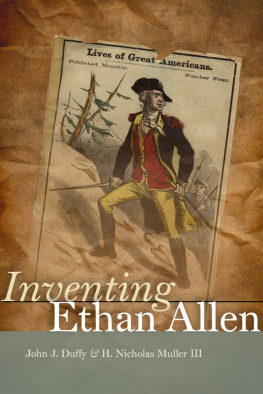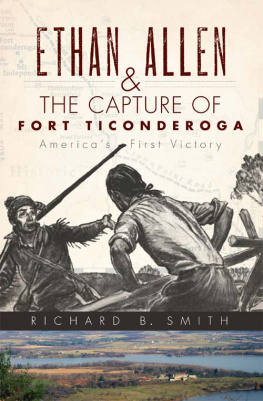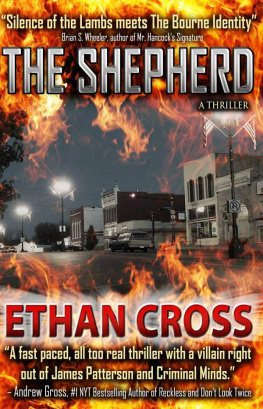ACKNOWLEDGMENTS
Around Christmas 2010 Nick Muller finished a rough draft of an article on Ethan Allens death and the events that immediately followed. Earlier, writing a piece that appeared in Vermont History in 2007 asserting that no evidence points to Ethan Allen uttering what has become his famous The gods of the hills are not the gods of the valleys, he had noticed anomalies, contradictions, and exaggerations surrounding Allens death. His son, Brook, marked it up, and Nick sent the improved version to John Duffy for his opinion. They had previously co-authored several journal articles and a book. From his researching and assembling the Allen family correspondence that appeared in the two-volume Ethan Allen and His Kin: Correspondence, 17721819 (1998), John had become the best sounding board for work on Allen. John responded quickly, suggesting the draft article should become a chapter in a larger exploration of the many questions surrounding Ethan Allens life, the epic story that emerged, and the creation of a Vermont hero. John and Nick met in Plattsburgh, more or less conveniently between their respective residences in Isle La Motte, Vermont, and Essex, New York, discussed the project, and produced a chapter outline. That outline changed over time, sometimes in response to colleagues who read and commented on early drafts.
We have a deep gratitude to good people who in various ways nudged, helped, and encouraged the completion of this book. Many had become friends and colleagues of ours over the years as we thought and wrote about Vermonts history. Others who share our mutual interest we came to know in the course of writing this book. To all of them, we say, thank you very much for their help and encouragement.
Michael Sherman, editor of Vermont History and co-author of Freedom and Unity, helped sow the seed for the book over the past two decades by publishing our essays and reviews. Several of our colleagues who read the early drafts contributed to the improvements in the original chapter outline. J. Kevin Graffagnino, director of the William L. Clements Library at the University of Michigan, applied his sharp critical sense and red pen to improve the manuscript. His own research and publication provided answers for many questions about Vermonts past. Ralph H. Orth, Marshall M. True, Connell Gallagher, and James R. LaForest read all or portions of the early drafts, made organizational suggestions, and proffered caveats, especially about retaining focus on the creation of an icon and not the debunking of a hero.
Other friends and colleagues brought their special knowledge to bear. Gregory Sanford, emeritus Vermont state archivist, and Paul Carnahan, librarian, Vermont Historical Society, helped us search for a spy who reported Allens intentions to ally with the British to his spymaster in Quebec, a figure known only by the code name Telemachus. A positive identification of Telemachus would have emphasized Allens seriousness in the Haldimand Negotiations beyond his admirers excuses about a separate peace with Britain. We did not locate it. Paul Carnahan also helped in other ways, providing photographic images to illustrate the text and rosters of early members of the Vermont Historical and Antiquarian Society. At Special Collections, Bailey-Howe Library, the University of Vermont, Jeff Marshall, Chris Burns, Prudence Doherty, Ingrid Bower, Nadia Smith, and Silvia Bugbee provided a welcoming environment for us, retrieving obscure manuscripts and suggesting additional documents we found useful. Special Collections at UVM also helped with the illustrations.
Others lent their particular expertise. Eugene A. Coyle of Oxford University shared his ardent research into the Irish aspects of the Crean Brush story, Ira Allens international arms purchases and related political schemes, and Ethan Allens Irish benefactors at Cobh Harbor in early 1776.
David Bennett of Ottawa, Ontario, and Montgomery, Vermont, pursued and shared with us his lively interest in Ethan Allens Canadian connections. UVM Professor Harvey A. Whitfield opened his research and conveyed his insights into the place of slavery in early Vermont history. Former U.S. Attorney Gary Shattuck, Esq., shared his extensive research and knowledge of late eighteenth- and early nineteenth-century Vermont legal and court records in the Vermont State Archives.
We thank Mark Bushnell of the Barre-Montpelier Times-Argus and the Rutland Herald and Tim Johnson of the Burlington Free Press for their continuing interest in the story of Ethan Allen. Thank you as well to John Devino and The Ethan Allen Homestead Trust for an invitation to present a draft chapter of this book with a friendly and interested audience. Thanks also to the Vermont Genealogical Society for its invitation to present a draft chapter at their Annual Meeting in 2012.
We found many folks willing to assist in the issue of the look-alike versions of the Larkin Meade statue of Ethan Allen in the National Statuary Hall Collection in the U.S. Capitol. Ellen McCullough-Lovell, former director of the Vermont Arts Council and now president of Marlboro College, shared her interest in the statues of Ethan Allen and led us to others with similar interests, including David Schtz, curator of the Vermont State House. John Dumville, state historic sites operations chief, provided important information on the statue of Allen at the Vermont State House and guided us to staff at the Bennington Battle Monument for information about the statue of Seth Warner there. Tyler Resch at the Bennington Museum directed us to Richard B. Smith of the Manchester Historical Society for information about the look-alike Green Mountain Boy statue in Manchester and the history of that memorial. John Huling, Bennington photographer, musician, and seventh-generation Vermonter, provided photographs of the statues in Manchester and Bennington to compare with the Ethan Allen statue in the U.S. Capitol. Thank you all.
Gene Sessions, emeritus professor of history at Norwich University, and Danielle Rougeau in Special Collections, Middlebury College Library, researched the earliest Ph.D.s who taught American history at their institutions. Christopher Fox, Anthony D. Pell Curator of Collections at Fort Ticonderoga, made archival material available and assisted with the illustrations.
Thank you University Press of New England Director Michael Burton and Editor-in-Chief Phyllis Deutsch for accepting the manuscript and entering into production with alacrity. Their decision to intersperse the illustrations where they illustrate the text has pleased us greatly.
After roughly two years of writing the book and often paying attention to it rather than other matters, we wish to thank Carol Muller for patiently reading drafts, making comments, and cleaning up writing problems on material that did not especially enthrall her, and Barbara Duffy for her enduring patience with yet another book project.
We are grateful to the named institutions and individuals for their permission to publish in this book copies of images credited to their collections.
JJD & HNMIII
APPENDIXES
APPENDIX A
Vermont Historiography, 180750: Change and Response
The emergence of Ethan Allen as an iconic Vermont figure and the founding father of Vermont occurred in the decade of the 1830s. By 1850 it had become fully accepted. Henry Stevens, a founder of the Vermont Historical and Antiquarian Society (hereafter the Vermont Historical Society) in 1838, and his contemporaries deliberately invented the new Ethan Allen in response to social, economic, and political developments they found perplexing and disturbing. Stevens, who achieved varying levels of success as an innkeeper, farmer, turnpike investor, and merchant, participated in local politics and twice represented Barnet in the legislature. He kept his ties in Montpelier active. Members of the upper middle class to which Stevens aspired and Vermonts intellectual elite feared society had become soft, that the old hearts of oak are gone.
Next page









